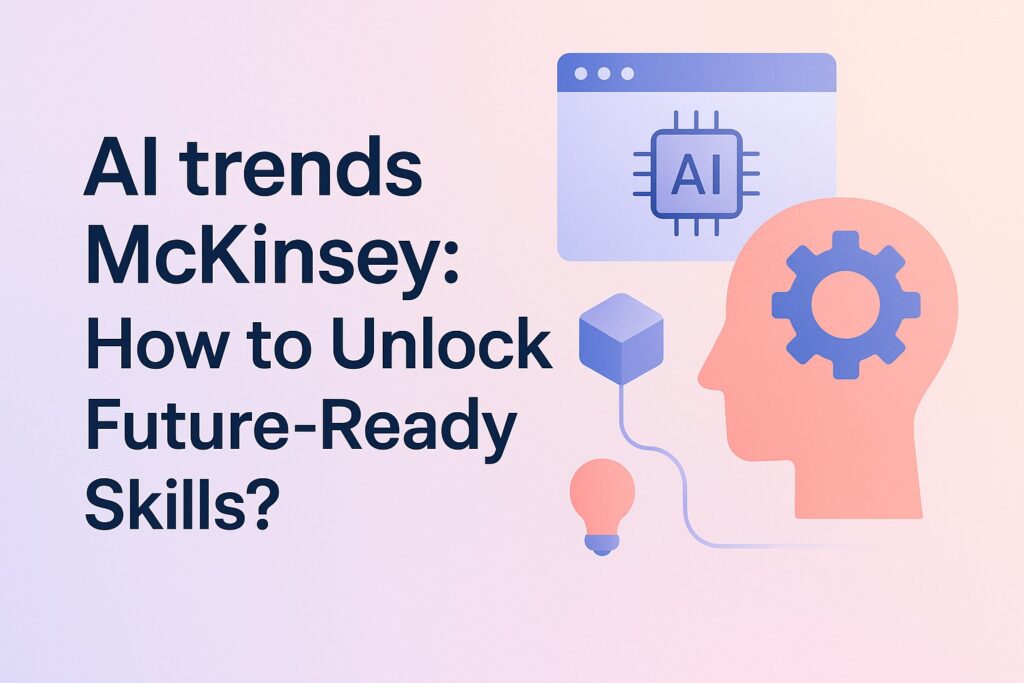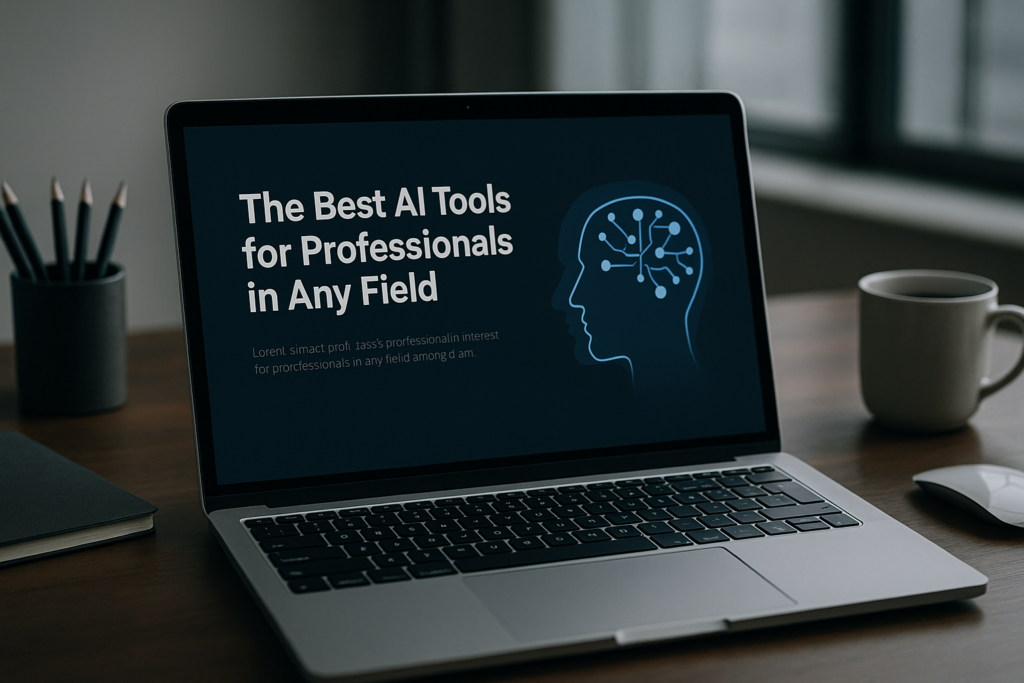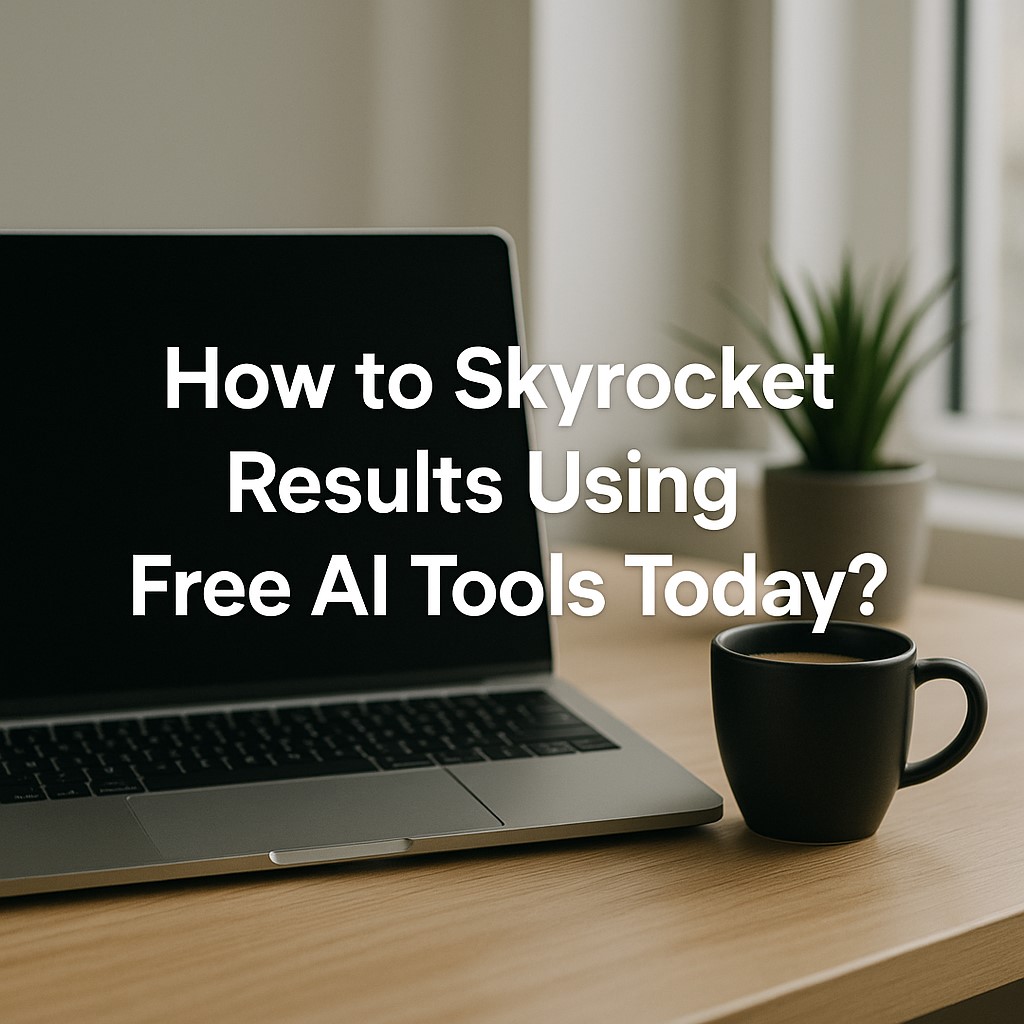Curious about how AI is changing the world around you? These cool insights from AI trends McKinsey break it down in a way that makes sense.
AI is changing the world fast, and McKinsey is one of the top voices tracking how it’s happening. Each year, they dive deep into how businesses are using AI to solve real problems. These updates are known as AI trends McKinsey reports.
But what exactly are AI trends McKinsey talking about? Simply put, they show how companies are using artificial intelligence in smarter, faster, and more useful ways. From customer service chatbots to powerful data tools, AI is helping businesses save time and money.
For students, this is a big deal. Why? Because the way people work, learn, and even shop is changing. And knowing what’s coming can help you prepare for future jobs and skills. AI trends McKinsey give you a sneak peek into what’s next—and where you might fit in. Whether you’re into tech or just curious about how AI works, these trends are worth checking out.
Table of contents
- How AI trends McKinsey are shaping business strategies?
- Top AI trends McKinsey predicts for healthcare in 2025
- AI trends McKinsey: navigating automation in business
- Key AI trends McKinsey highlights for finance transformation
- AI trends McKinsey: benefits for digital transformation
- AI trends McKinsey: overcoming adoption challenges
- How do AI trends McKinsey drive innovation in enterprises?
- AI trends McKinsey: Impact on industries you should know
- AI trends McKinsey: strategic insights for business leaders
- AI trends McKinsey: Key insights on machine learning
- AI trends McKinsey: How AI is disrupting finance
- FAQs: AI trends McKinsey
- Final thoughts
How AI trends McKinsey are shaping business strategies?
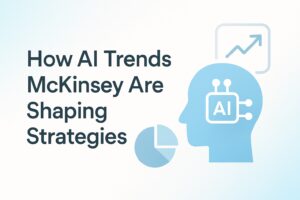
Smarter decisions, faster growth. AI is changing how businesses think, plan, and grow. According to AI trends McKinsey shared in recent reports, companies are using AI to stay ahead in competitive markets. These trends are not just about tech—they’re about strategy.
AI helps leaders make faster decisions
Today, smart tools give instant insights. With AI, leaders don’t have to wait for monthly reports. AI trends McKinsey show that companies using AI dashboards can adjust their plans in real time. This helps them save time, avoid mistakes, and act faster than others.
Predicting customer needs becomes easier
One key strategy is using AI to understand customers. By analyzing data, AI can guess what people want—even before they say it. McKinsey says this helps businesses personalize services and boost customer loyalty. It also finds patterns humans might miss.
It trends McKinsey highlight that using these predictions leads to smarter product launches and better marketing plans.
AI supports flexible business models
Instead of one fixed way of working, companies are now more flexible. AI helps them test new models quickly. For example, a company can use AI to test a new product idea on a small group before going big. McKinsey says this lowers risk and increases innovation.
AI trends McKinsey prove that AI isn’t just a tool—it’s part of the business playbook now. It helps companies grow smarter, not just bigger.
Top AI trends McKinsey predicts for healthcare in 2025
AI is changing how doctors treat and care for patients. Healthcare is going through a big tech upgrade. AI trends McKinsey shared for 2025 show how hospitals and clinics are using AI to help patients faster and more accurately.
Smarter diagnosis with fewer errors
One top trend is using AI to detect diseases early. AI tools now scan X-rays, MRIs, and lab results quicker than doctors can. AI trends McKinsey highlight how this leads to fewer mistakes and earlier treatments, especially in cancer and heart disease.
Personalized treatment plans AI trends McKinsey
Not all patients are the same. AI helps doctors create plans based on a person’s health data, genes, and habits. McKinsey points out that this makes treatments work better and reduces side effects. It also saves time by avoiding guesswork.
AI trends McKinsey say this shift to personalized care will be a game changer, especially for young patients and those with long-term conditions.
Better hospital operations
AI isn’t just for doctors—it helps hospitals run smoother too. From managing beds to predicting medicine needs, AI keeps things moving. McKinsey predicts that by 2025, more hospitals will use AI to cut wait times and improve care.
AI trends McKinsey prove that AI in healthcare isn’t just a cool idea—it’s already making real impact. And by 2025, it’ll be even more important in saving lives.
AI trends McKinsey: navigating automation in business
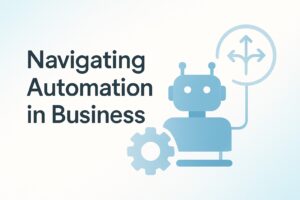
From routine tasks to smarter workflows. Automation is no longer just about robots in factories. It’s now a key part of office jobs, customer service, and online work. According to AI trends McKinsey, businesses in every industry are using AI-powered automation to work smarter—not harder.
Replacing repetitive tasks
Think of all the small, boring jobs done every day—like entering numbers into spreadsheets, sorting emails, or copying info from one system to another. AI can now do these tasks without taking breaks or making typing mistakes.
AI trends McKinsey reveal that companies using automation save tons of time and money. For example, a bank can use AI to review loan applications automatically, instead of having someone check each one manually. This means faster results for customers—and less stress for workers.
Boosting speed and accuracy
Automation doesn’t just make things faster—it also makes them more accurate. AI systems are great at following rules. They can double-check huge amounts of data and spot errors that humans might miss. For example, an online store can use AI to track thousands of orders and alert managers if something goes wrong.
AI trends McKinsey explain that this kind of accuracy helps businesses avoid big mistakes. It also builds customer trust—because things run smoothly, and people get what they need on time.
Creating new job roles
Some students worry that AI will take away jobs. But here’s the good news—AI trends McKinsey show that automation often leads to new careers. When AI takes over boring or hard tasks, people get to do more creative and meaningful work.
For example, instead of manually tracking sales, someone might become a data analyst who uses AI insights to improve business strategies. Or they might work in designing and training AI systems to make them even smarter.
AI trends McKinsey prove that the future of work isn’t just about machines—it’s about people and AI working together. Businesses that learn how to mix both are the ones growing the fastest.
Key AI trends McKinsey highlights for finance transformation
Smarter tools, faster decisions, safer money. Finance is changing fast—and AI is driving the change. According to AI trends McKinsey, banks, fintech companies, and financial teams are using AI to work better, spot risks early, and make sharper money moves.
AI makes financial data easier to understand
Finance involves tons of numbers and patterns. AI helps turn all that data into clear insights. With tools that track spending, predict market trends, and flag errors, teams can react quickly. AI trends McKinsey show that this is helping companies plan smarter budgets and catch mistakes before they cost too much.
For example, AI can spot strange activity on a bank account in seconds—way faster than a human could.
Risk detection and fraud prevention
One of the most important uses of AI in finance is keeping money safe. AI scans thousands of transactions and looks for anything suspicious. It learns from past fraud cases and gets better over time. AI trends McKinsey highlight how this tech helps banks protect users and stop fraud before it happens.
That’s a big win for both businesses and customers.
Automating reports and audits
Creating financial reports and doing audits used to take weeks. Now, AI can handle much of that work. It pulls the right data, fills out forms, and even checks for rule-breaking. AI trends McKinsey explain that this saves time, reduces human error, and helps teams stay focused on bigger goals. By using AI, finance departments become more efficient and reliable.
AI trends McKinsey show that finance isn’t just about spreadsheets anymore. It’s about using smart tools to make better, faster, and safer decisions. And this shift is only getting bigger in 2025.
AI trends McKinsey: benefits for digital transformation

How AI helps businesses go fully digital? Digital transformation means switching from old-school methods to smarter, tech-driven ways of working. And according to AI trends McKinsey, AI is a major part of that change. It helps companies improve speed, make smarter choices, and serve customers better.
Faster decisions with real-time data
AI tools collect and analyze data super fast. This means businesses don’t have to wait days or weeks for reports—they can see what’s happening in real time. AI trends McKinsey highlight how this helps leaders make quick, smart decisions. For example, an online store can use AI to adjust prices or fix delivery issues right away. It’s not just faster—it’s more accurate too.
Better customer experiences
Digital transformation is also about making things easier for customers. AI helps with that. Chatbots answer questions 24/7, apps give personal recommendations, and support teams use AI to solve problems faster. AI trends McKinsey show that companies using AI like this have happier users and stronger customer loyalty. People now expect fast, personalized service—and AI helps deliver it.
Smarter, simpler systems
When companies go digital, they often deal with a mess of apps and data. AI helps organize and connect these systems. It can pull data from different sources, find patterns, and suggest what to do next. AI trends McKinsey explain that this makes the whole business more flexible and future-ready.
By following AI trends McKinsey, businesses can make digital transformation smoother, faster, and more useful. And that means they’ll stay ahead in a fast-changing world.
AI trends McKinsey: overcoming adoption challenges
Solving the real problems of using AI at work. Bringing AI into a business sounds exciting—but it’s not always easy. Many companies face roadblocks when trying to make AI work. According to AI trends McKinsey, these challenges are common, but they’re also fixable.
Not everyone trusts AI
One big issue is trust. People worry AI might take their jobs or make wrong decisions. Some teams don’t understand how it works, so they avoid using it. AI trends McKinsey highlight that training and clear communication help build confidence. When teams learn how AI supports them—not replaces them—they start to see the value. Trust grows when people know what AI can and can’t do.
Missing the right skills
Another challenge is the skills gap. Businesses want to use AI, but their teams may not have the tech knowledge. AI trends McKinsey point out that hiring experts and training current staff is key. Even simple tools need people who understand how to guide and manage them. Learning about AI doesn’t mean you need to be a coder. You just need to know how to use it.
Struggling with data
AI needs data to learn and work well. But messy or missing data is a big problem. Some companies don’t know how to collect, clean, or organize their data. AI trends McKinsey show that fixing this is a top priority. Without good data, even the best AI tool won’t help much. Strong data = smart AI. That’s the rule.
By following AI trends McKinsey, companies can face adoption challenges head-on. It’s not about doing everything at once. It’s about taking small steps, learning, and growing with the tech.
How do AI trends McKinsey drive innovation in enterprises?
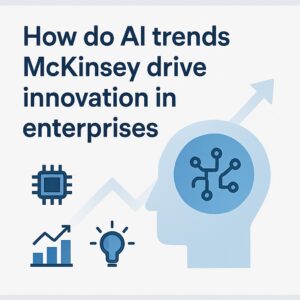
Smart ideas, faster growth, and bold moves with AI. Enterprises are always looking for ways to grow, solve problems, and stay ahead. According to AI trends McKinsey, artificial intelligence is now one of the biggest drivers of innovation in large companies. It helps teams think differently, work faster, and build new solutions.
AI boosts product development
When creating new products, speed and testing are key. AI helps by analyzing what customers want, spotting trends, and even designing prototypes. AI trends McKinsey show that enterprises use AI to speed up the product design process. It saves time and lowers the cost of trial and error. That means new ideas can turn into real products much quicker.
Smarter decision-making
Big companies have tons of data. But data alone isn’t useful unless it leads to action. AI helps leaders make smarter choices by finding patterns and predicting outcomes. AI trends McKinsey highlight how businesses now rely on AI to decide where to invest, what risks to avoid, and how to improve daily operations. Good decisions come faster when AI handles the heavy lifting.
Encouraging creative thinking
AI doesn’t just do boring tasks—it sparks creativity too. Enterprises use AI tools to brainstorm new marketing ideas, plan strategies, and even write content. AI trends McKinsey prove that innovation is no longer just for tech teams. With the right AI tools, every department can try bold ideas and test them quickly.
So, how do AI trends McKinsey really help? They push enterprises to think big, try new things, and stay ready for the future. And that’s what real innovation looks like.
AI trends McKinsey: Impact on industries you should know
It is changing more than just tech—it’s transforming entire industries. It isn’t just for computer experts or giant tech companies. It’s making big waves in many industries. According to AI trends McKinsey, sectors like retail, finance, healthcare, and manufacturing are using AI to improve faster, cheaper, and smarter. Let’s look at how.
Retail gets personal
In retail, AI helps stores know what you want—even before you do. It tracks shopping patterns, suggests products, and manages stock. AI trends McKinsey highlight how companies use AI to personalize shopping and boost sales. It also helps with things like chatbots and online support, making shopping smoother. Smart stores are winning customers with AI-powered experiences.
Healthcare moves faster
Doctors now use AI to read scans, predict illnesses, and manage patient records. This saves lives and time. AI trends McKinsey show that AI helps hospitals diagnose diseases more accurately. It also supports virtual care, making healthcare more available and efficient. With AI, health solutions are faster and more reliable.
Manufacturing becomes smarter
Factories are using AI to spot problems early, manage machines, and plan production. AI trends McKinsey explain how smart factories reduce waste and increase safety. AI even helps predict when machines will break so they can fix them before they stop working. Production lines are becoming cleaner, quicker, and safer—all thanks to AI.
By following AI trends McKinsey, you can see how different industries are being transformed. Each one is using AI in unique ways to solve problems and grow faster. It’s not just a tech trend—it’s a whole new way of doing business.
AI trends McKinsey: strategic insights for business leaders
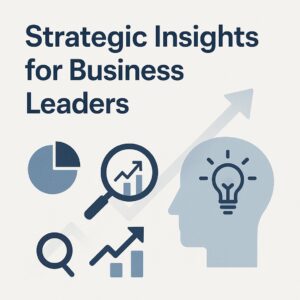
What business leaders need to know about AI’s future impact? AI isn’t just some futuristic idea anymore. It’s a big deal right now, and it’s changing the game for businesses. According to AI trends McKinsey, business leaders need to pay attention to these changes to stay ahead. Let’s take a look at how AI can help leaders make smarter moves and drive their businesses forward.
Make decisions based on data
One key point from AI trends McKinsey is that data is everything. Leaders can use AI to dive deep into data and make faster, smarter decisions. AI tools can analyze tons of data in seconds, giving leaders insights they might take forever to find on their own. By focusing on data, business leaders can make decisions that are more accurate and better timed.
Data helps leaders make the right calls, fast.
Innovate products and services
AI is also changing how businesses create new products and services. AI trends McKinsey show that AI helps with everything from designing products to improving customer service. Business leaders who use AI can come up with new ideas faster, find ways to improve what they already offer, and even spot opportunities they might have missed before.
Using AI means staying ahead of the competition and offering better products.
Build stronger customer connections AI trends McKinsey
AI is great for connecting with customers too. AI trends McKinsey point out that AI tools like chatbots and recommendation systems can make interactions more personal and engaging. When businesses use AI to understand their customers better, it builds trust and keeps people coming back. The more businesses use AI to connect with customers, the more loyalty they build.
For business leaders, staying updated on AI trends McKinsey is essential. It’s about understanding how AI can fit into their current strategies, using data to make better decisions, and finding new ways to connect with customers. Leaders who embrace AI today will be the ones leading tomorrow.
AI trends McKinsey: Key insights on machine learning
How is AI changing industries?
AI trends McKinsey shows that machine learning is becoming a game-changer for many industries. Companies are using AI to work faster and smarter. For example, businesses are now using machine learning to look through big amounts of data quickly. This helps them make better decisions and stay ahead of the competition. Industries like healthcare and finance are leading the way, finding new ways to use AI for growth.
The rise of smarter machines
AI trends McKinsey also talks about how machine learning models are getting smarter. These models can learn from data and make decisions on their own. As they keep learning, they get more accurate. Now, companies use machine learning for tasks that used to take a lot of time or needed humans to do them. From chatbots that help customers to systems that catch fraud, AI is making things faster and more reliable.
What does AI mean for jobs in the future?
Looking ahead, AI trends McKinsey predicts that the way we work will change because of AI. More companies are jumping into AI, and that means jobs will look different. While some roles might change, new opportunities will pop up in fields like AI development and data science. So, if you’re thinking about the future, getting skills in machine learning could be a smart move. The demand for AI skills is growing, and it’s an exciting time to get into it.
AI trends McKinsey: How AI is disrupting finance
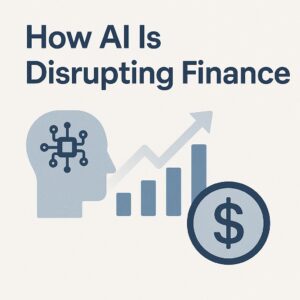
Big changes in how money moves?
AI trends McKinsey shows that artificial intelligence is shaking up the finance world in a big way. Banks and financial companies are using AI to handle tasks that used to take hours. Now, smart systems can check transactions, spot fraud, and even help customers—all in seconds. This makes things faster, safer, and more accurate.
Smarter decisions with less guesswork
Thanks to AI trends McKinsey, we see how financial firms are using machine learning to make smarter choices. These systems look at huge amounts of data and find patterns humans might miss. This helps companies make better predictions, like where to invest or when to flag risky loans. The cool part? It reduces guesswork and helps businesses save money.
AI trends McKinsey also explains that this shift is helping small businesses and regular people too. AI tools can help users budget, track spending, and even plan for the future. That means better financial health for everyone—not just big banks.
What this means for your future?
As AI grows, finance jobs will change. According to AI trends McKinsey, some tasks will become fully automated, while new roles will pop up. People who learn how to work with AI—like building models or understanding data—will be in high demand. So, if you’re into tech or business, this could be a great path to explore.
FAQs: AI trends McKinsey
What are AI trends according to McKinsey?
AI trends McKinsey shares include how AI is being used in real businesses. These trends show where AI is helping most—like in saving time, cutting costs, and making smart decisions. McKinsey also tracks how fast companies are using AI across different industries.
Why does McKinsey study AI trends?
McKinsey studies AI trends to help businesses understand what’s working. They collect data from real companies and show how AI is changing the way people work. This helps others know where to invest and what skills to learn. AI trends McKinsey also points out which industries are using AI the most and what kind of results they’re getting. That makes their reports super useful for anyone interested in tech.
How often does McKinsey update its AI trends?
McKinsey shares new insights on AI trends every year. They study how AI is growing and what new tools or uses are showing up. Each report is based on surveys from business leaders all over the world.
What makes AI trends McKinsey reports special?
AI trends McKinsey are trusted because the data comes from real companies. The reports include case studies and detailed results. They don’t just talk about AI—they show how it works in real life.
Can students use AI trends McKinsey for learning?
Yes! Students can use AI trends McKinsey to learn how AI is used in business. These reports are great for projects, research, or just staying updated. They also help students choose careers in tech and data. AI trends McKinsey can even give you ideas about what skills are in demand, like coding, data science, and machine learning.
Are there any surprises in McKinsey’s AI research?
Yes, sometimes! For example, AI trends McKinsey once showed that smaller companies are now using AI more than ever. It’s not just big tech firms anymore. That’s a sign AI is becoming more available to everyone.
Final thoughts
AI trends McKinsey shows how fast AI is growing across different industries. From finance to tech, companies are using AI to work smarter and faster. These trends also highlight new job skills and tools that are becoming more important. Machine learning, data analysis, and automation are just the beginning.
AI trends McKinsey gives a clear view of what’s happening now—and what’s coming next. That’s helpful for students who want to stay ahead in school or plan for future careers. Whether you’re into business, coding, or just curious about AI, there’s something to learn from these insights.
AI trends McKinsey makes it easier to see where the world is going with tech. It’s a great way to stay informed without getting overwhelmed. The future is being shaped by AI—and it’s moving fast. Will you be ready to keep up?

